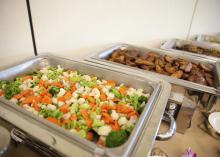Information Possibly Outdated
The information presented on this page was originally released on January 15, 2015. It may not be outdated, but please search our site for more current information. If you plan to quote or reference this information in a publication, please check with the Extension specialist or author before proceeding.
Food safety tips keep wedding guests smiling
MISSISSIPPI STATE -- Food-borne illnesses are not popular wedding favors, and brides can keep their guests smiling by practicing a few simple food safety tips.
Natasha Haynes, host of “The Food Factor” and an agent in Rankin County for the Mississippi State University Extension Service, said many families organize do-it-yourself wedding receptions to reduce food costs.
“After investing in the ingredients for a wedding reception, you don’t want to let them go to waste because of poor storage or serving options,” Haynes said.
No matter how much planning goes into a wedding and reception, knowing exactly when to set out food is a challenge. Serving it too soon can result in cold foods that get too warm or hot foods that cool too quickly.
“Everyone wants to be at the wedding, yet the reception needs to be ready and waiting for the guests and wedding party to arrive,” Haynes said. “Having the reception at a different venue can pose an additional challenge. Organization is the key.”
Haynes said diagrams of the tables and notes identifying locations for hot and cold items will make serving the food a quicker process.
“The bride can identify friends who can leave the wedding festivities a bit early and ask them to focus on setting up the reception,” Haynes said. “Whoever is in charge of the reception should create a step-by-step list of what to serve first to make delegating tasks easier.”
Couples can rent or borrow special serving equipment designed to keep cold foods cold and hot foods warm, but the key to food safety is monitoring temperatures.
“Sometimes it’s smarter to choose smaller serving dishes and simply bring out fresh platters, bowls or trays when the others get close to empty,” Haynes said. “This strategy keeps food out for a shorter period of time and within the right temperature range.”
Hot foods need to be 140 degrees or hotter. Cold foods need to be 40 degrees or colder.
“If something has been out on a table without any temperature control for more than two hours, then it’s best to throw it out,” Haynes said.
Transferring food from serving dishes to plates is an opportunity for guests to share both fellowship and germs.
“It’s important to have plenty of serving utensils available so hungry guests don’t resort to using their hands to grab fruit, slices of cheese, vegetables or tasty appetizers,” she said. “They often pop those items into their mouths, and when they reach for the next treat, they transfer their germs to the food in the serving dish.”
Ask a trusted friend to monitor the reception table and help older guests fill their plates and prevent younger guests from touching several items before choosing one, Haynes advised.
“An extra set of hands and eyes can help keep the buffet line running smoothly if guests are serving themselves,” she said. “Remind guests to get a clean plate each trip through the buffet.”
When Dawn Vosbein, an Extension agent in Pearl River County, got married 25 years ago, she and her groom fit the reception fare to the location.
“We got married at City Park in New Orleans, and served hors d’oeuvres,” Vosbein said. “But where I grew up, in northern Michigan, a wedding reception was more like a potluck, with big pans of hot food, like stuffed cabbage rolls and lasagna. So my advice when doing your own reception is to consider the location when menu planning.”
The temperature requirements for food mean a much different menu for an outdoor reception when it is 85 degrees outside, compared to an indoor reception with air conditioning.
“Brides need to have realistic expectations about how food is going to hold up over the course of the reception and plan accordingly,” Vosbein said. “Some food items survive well, but others change texture and lose quality.”
Frugal brides may bring containers or bags to save food from the reception, but Vosbein said food should be checked for temperature and quality before being saved for future use.
“If you can save food in the refrigerator and only put it out when it’s needed, you may have extras that are definitely safe to keep,” she said. “But if you have, say, some type of dip or cheese that hasn’t been kept on ice, you have to remember when it was served, and most of that type of food will need to be thrown out.”
Many couples are so busy during the reception they do not get to eat. Ideally, someone will prepare a to-go basket in advance and keep it refrigerated until the newlyweds leave the reception. If buffet items are included, they should be placed in a cooler.
“That food may have been sitting out for a while and will need to be chilled and then put in a refrigerator if not eaten immediately,” Vosbein said. “No couple wants to have a food-borne illness on their honeymoon.”




